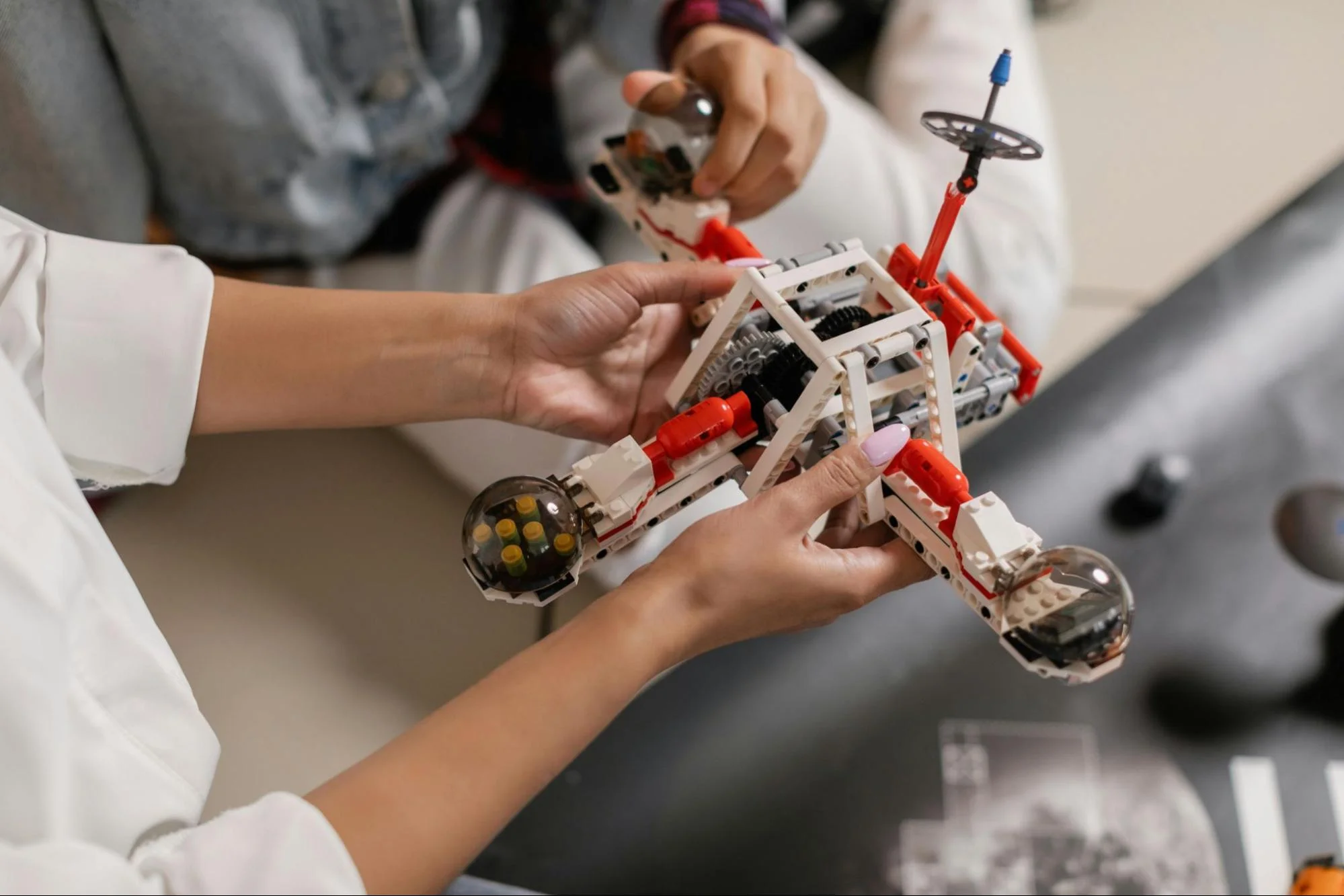Update: This article was last updated on 23rd December 2024 to reflect the accuracy and up-to-date information on the page.

If you’re not interested in enrolling your child in afterschool robotics classes or online lessons, you can design a robotics homeschool curriculum to introduce them to the basics of coding, electronics, and mechanical engineering. This approach will keep your child technologically literate and equip them with skills needed for future careers in STEM fields such as robotics, automation, and artificial intelligence.
A well-crafted robotics homeschool curriculum fosters critical thinking, problem-solving skills, and creativity, all while building a strong foundation in the fundamentals of robotics.
Why Include Robotics in Your Homeschool Curriculum?
There are numerous advantages of incorporating robotics into your homeschooling journey. Here are some key benefits:
1. Boosts STEM Skills: Robotics projects for kids naturally integrate math, science, engineering, and technology. Building and programming robots reinforce important concepts in mechanics, electronics, physics, and computer science.
2. Encourages Problem-Solving: Robotics projects often present challenges that require students to think critically, troubleshoot, and develop solutions. This iterative process fosters resilience and independent thinking.
3. Sparks Creativity: Designing and building robots allows students to express their ideas in a tangible way. Robotics projects for kids can be tailored to various interests, from building robots for specific tasks to creating artistic creations.
4. Increases Confidence: Completing a robotics project provides a sense of accomplishment and boosts confidence. Seeing their robots come to life motivates students and encourages them to tackle more complex challenges.
5. Prepares for the Future: Robotics is playing an increasingly important role in various fields. Giving your homeschooled children a head start in this area could give them a competitive edge in future careers.
Key Components of a Robotics Homeschool Curriculum

A well-rounded robotics homeschool curriculum should encompass several key components to provide a comprehensive learning experience.
1. Basic Concepts and Theories:
A strong foundation in core concepts is essential before diving into hands-on projects. Age-appropriate introductions to the following topics will prepare the students:
- Mechanics: Introduce basic concepts like gears, levers, pulleys, and motors. Explain how these components work together to create movement.
- Electronics: Cover fundamental concepts of circuits, sensors, and actuators. Explore how these components work together to interact with the environment.
- Robotics Fundamentals: Introduce basic robot anatomy, including different types of robots (e.g., industrial, service, educational) and their functions.
Learning Resources:
- Textbooks or online resources specifically designed for beginner robotics.
- Engaging videos and documentaries about robots and their applications in the real world.
- Interactive online simulations that allow students to experiment with basic robotic principles.
2. Hands-On Projects:
Hands-on projects are the heart of any robotics curriculum. Start with simple projects and gradually increase complexity as your students gain experience. Here are some ideas:
- Line Follower Robot: Build a robot that can follow a black line on a white surface. This teaches students about sensors, motors, and basic programming concepts.
- Maze Solving Robot: Design a robot that can navigate a maze. This project introduces problem-solving, pathfinding algorithms, and sensor integration.
- Remote-Controlled Robot: Construct a robot that can be controlled remotely. This project focuses on motor control, wireless communication, and user interface design.
3. Choosing the Right Kits:
There are numerous robotics kits available for different age groups and skill levels. Consider the following factors when selecting a kit:
- Age and Skill Level: Choose a kit that is age-appropriate and matches your student’s current skill level. Beginners might benefit from simple snap-together kits, while more advanced students can explore programmable kits.
- Features and Functionality: Select a kit that aligns with your curriculum goals and allows students to experiment with specific concepts.
- Budget: Robotics kits range in price. Consider your budget and prioritize features that align with your learning objectives.
4. Programming and Coding:
Learning basic programming skills is crucial for controlling robots and adding advanced functionality. Consider options like:
- Scratch: A beginner-friendly visual programming language specifically designed for children.
- Python: A powerful and versatile programming language that can be used for complex robotics projects.
- LEGO Mindstorms: Many LEGO robotics kits come with user-friendly programming environments.
Learning Resources:
- Online coding tutorials and courses tailored to different age groups and programming languages.
- Educational apps and games, for instance, ‘Moonprenuer’s Robotics Program’ introduces programming concepts in a fun and engaging way.
5. Online Resources and Communities:
The internet offers a wealth of resources for homeschooling robotics enthusiasts. Utilize these resources to enhance your curriculum:
- Educational Websites: Several websites offer robotics lesson plans, tutorials, and project ideas specifically designed for homeschoolers.
- Online Forums and Communities: Connect with other homeschooling parents and students interested in robotics. Share experiences, ask questions, and get inspired by others’ projects.
Structuring Your Curriculum: Building a Roadmap for Robotic Adventures

We explored the key components of a robotics homeschool curriculum, it’s time to build a roadmap for your child’s learning journey. Here are some tips for structuring your curriculum:
1. Tailor it to Your Child’s Age and Interests:
- Age: Consider your child’s age and developmental level when choosing projects and concepts. Younger children might benefit from more visual and playful activities, while older students can delve deeper into programming and complex mechanics.
- Interests: Incorporate your child’s interests into the curriculum. For example, if they love animals, explore biomimicry robotics by building a robot inspired by an animal’s movement.
2. Start Simple and Gradually Increase Complexity:
Begin with foundational concepts and basic projects that build confidence and understanding. As your child progresses, gradually introduce more complex concepts and challenging projects. This incremental learning approach will ensure a smooth learning curve and prevent frustration.
3. Integrate Robotics with Other Subjects:
The beauty of robotics lies in its ability to bridge different subjects. Use robotics projects for kids as a springboard to explore related concepts in science, math, and other subjects.
- Science: While building a robot, explore concepts like force, motion, and energy transfer.
- Math: Incorporate geometry and spatial reasoning when designing robot parts or planning movements.
- Language Arts: Encourage students to document their projects, write code comments, or create stories featuring their robots.
4. Plan for Flexibility and Exploration:
While having a structured curriculum is important, leave room for exploration and independent learning. Encourage your child to experiment, test their ideas, and troubleshoot challenges. This fosters problem-solving skills and creativity.
5. Consider Pacing and Learning Style:
Every child learns at their own pace. Structure your curriculum to accommodate your child’s learning style, be it visual, auditory, or kinesthetic. Go for different teaching methods, such as hands-on activities, demonstrations, and visual aids.
6. Integrate Assessment and Feedback:
Regularly assess your child’s progress by observing their project development, coding skills, and problem-solving strategies. Provide constructive feedback to guide their learning and celebrate their achievements.
7. Explore Competitions and Clubs:
Participating in robotics competitions or clubs can provide a sense of community, healthy competition, and motivation for your child. It’s a great way for them to showcase their creations, learn from others, and receive valuable feedback from experienced mentors.
Additional Tips: Powering Up Your Robotics Learning Journey

Make it Fun!
Robotics should be an engaging and enjoyable experience. Incorporate games, challenges, and themed projects to keep your child motivated.
Embrace Open-Ended Learning
Pose open-ended questions and encourage your child to think critically and come up with creative solutions.
Safety First
When working with electronics and robotics kits, ensure you follow safety guidelines and provide proper supervision.
Document Your Journey
Encourage your child to document their projects through photos, videos, or even a robotics journal. This helps track their progress and provides a sense of accomplishment.
Celebrate Achievements
Take the time to celebrate your child’s successes, no matter how small. This motivates them to continue learning and take on new challenges.
Connect with the Maker Community
Explore local maker spaces, online forums, or robotics clubs to connect with other homeschooling families and enthusiasts. This provides opportunities for collaboration, knowledge sharing, and peer support.
Incorporate Real-World Applications
Show your child how robots are used in various industries, like healthcare, manufacturing, and space exploration. This helps them understand the practical applications of their learning.
Encourage Teamwork
If you have multiple children, consider incorporating teamwork into some projects. This fosters communication, collaboration, and problem-solving skills within the family.
Make Use of Free Resources
Many online resources, tutorials, and lesson plans are available for free. Utilize these resources to enhance your curriculum and save on costs.
Consider Field Trips
Visit museums with robotics exhibits or attend robotics workshops and events whenever possible. This provides a valuable hands-on experience and sparks inspiration.
Think Outside the Box
Encourage your child to explore different materials and tools beyond robotics kits. Get creative and repurpose everyday items to add unique features to their robots.
Exploring the History and Cultural Impact of Robotics
Adding a historical and cultural perspective to your robotics homeschool curriculum can give your child a well-rounded and inspiring learning experience. Understanding the evolution of robotics not only highlights key milestones but also sparks curiosity about the future of this dynamic field.
1. The Evolution of Robotics
Begin with the origins of robotics, tracing its journey from the ancient automata of Greece and China to modern-day robots. Teach your child about historical landmarks, such as:
- Leonardo da Vinci’s Mechanical Knight (1495): An early design of a humanoid robot.
- The First Industrial Robots: Introduce concepts like the Unimate, the first robot used in manufacturing in the 1960s.
- The Emergence of AI Robots: Discuss how the robotics technology has transformed the tasks it performs to include AI such as navigation, speech recognition, and decision-making.
Combining these stories with your robotics homeschool curriculum sets the perspective of how the industry has changed with regards to entertainment and society.
2. Cultural Insights of Robotics
Robotics differs between cultures, and bringing this to your homeschool curriculum may allow your children to learn on a global perspective:
- Japan: Humanoid robotics: The place where technology merges with culture. Famous for humanoid robots and its recent creations, like ASIMO and Pepper, which showcase the latest robotics technology.
- United States: Emphasize the role of robotics in developing healthcare, defense, space exploration industries, such as NASA’s Mars rovers.
- Europe: Discuss contributions to industrial robotics from Germany, along with the ethical discussions about AI within the European Union.
- India and China: Explain how the developing nations are quickly implementing robotics into the learning, production, and agriculture sectors.
From this insight, your child can appreciate how the rest of the world is implementing robotics.
3. Applications in Everyday Life
Have your child build projects based on historical or cultural examples. Examples:
- Simple automaton based on simple gears and motors.
- Design a robot inspired by biomimicry, like those of animal-like robots in Japan.
Adding history and culture to your homeschool robotics program helps in a deep understanding and expands your child’s imagination and wonder about the world.
By following these tips and tailoring them to your child’s unique interests and learning style, you can create a robotics homeschool curriculum that fosters a lifelong passion for STEM education and prepares them for a future filled with innovation and exciting possibilities.
Want to make your child future-ready with Robotics? Moonpreneur offers a tailor-made program. Reserve a spot in our free 60-minute workshop today and introduce them to the amazing world of robotics and innovations!























